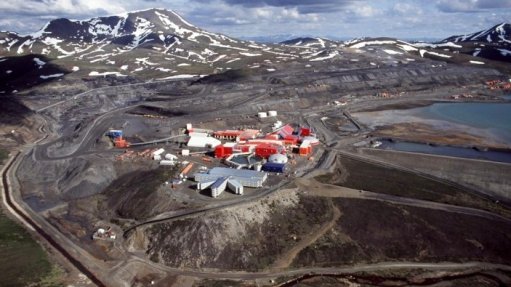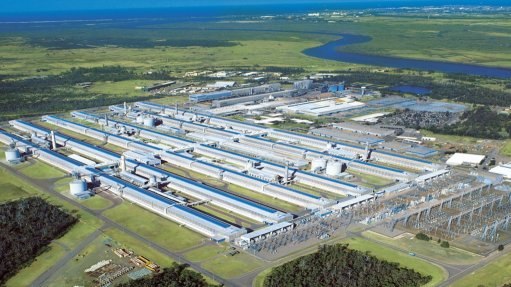Onus on sector to optimise steel capacity – SAISI


CHARLES DEDNAM Overall steel consumption decreased by 23% over the past decade, even as imports surged to 30% of total consumption
Amid the mounting challenges of slow economic growth and increased steel imports, steel representative organisation the South African Iron and Steel Institute (SAISI) emphasises the need to address trade barriers and use steel capacities effectively to unleash opportunities on the continent.
Overall steel consumption decreased by 23% over the past decade, even as imports surged to 30% of total consumption, highlights SAISI secretary- general Charles Dednam.
Thus, the primary challenges in the steel industry are the lack of domestic steel demand and the proliferation of imports. The high volume of imports is limiting local supply in an already distressed market and entering our market at competitive prices. A substantial volume of the imports, spurred by the more than 300- million tonnes worth of surplus steel capacity worldwide, eventually reach the least protected markets at reduced prices, making the trade environment unequal, explains Dednam.
“There are instances of imports of finished steel products entering our market at sub-raw material costs.”
In the wake of sizable manufacturing overcapacities locally, and in the global steel sector, the risk of accepting poor quality products is increasing as manufacturers, in an effort to maintain margins, may want to “cut corners” to contain costs.
He cites, for example, roll-formers’ “going thin” on roof sheeting, lowering coating thicknesses, sacrificing the corrosion resistance of the product to reduce costs – a scenario that epitomises the maladies of the current steel environment.
Dednam highlights another challenge: the supply chain encounters many difficulties with moving cargo using rail and through the ports, which affects inbound and outbound move- ment, and has a major impact on availability and in the end on the cost of steel in the country. Improvements to the country’s known and longstanding logistics constraints are viewed as solutions to drive down costs and mitigate the reliance on road freight.
The direction in which international tariff and nontariff trade barriers are moving also impacts the domestic and international steel trade. “More than 64 countries worldwide embarked on substantial protectionist measures to preserve their manufacturing base against the flood of imports. However, on a comparative basis, South Africa might be one of the least protected markets in the world, particularly with the current evidence of the incursion of distressed parcels entering the country,” says Dednam.
Reindustrialisation Efforts
In reflecting on the overall progress of the Steel Master Plan (SMP), SAISI stresses the importance of assessing whether this has contributed to creating more domestic demand.
“We are still at 4.5-million tonnes of steel consumption and at 1.2-million to 1.3-million tonnes of steel imports. So, the localisation side of the masterplan did not really materialise. Up till now, we haven’t managed to get ahead with many of the infrastructure projects on the books, keeping in mind that is where steel demand comes from,” Dednam explains, questioning whether government demonstrated sufficient political will to support the SMP comprehensively.
SAISI notes that the imperative to decarbonise the steel value chain is a costly exercise, partly owing to the variety of technical changes such a process requires.
“Having to convert an integrated mill, like the ArcelorMittal mill, in Vanderbijlpark, which is a blast furnace operation, into an eco-friendly plant, we are talking about billions of rands to actually execute an exercise of this magnitude with regard to the required technologies,” Dednam highlights.
Nevertheless, SAISI asserts that the steel industry is actively pursuing decarbonisation initiatives, with many steel mills in the country making considerable progress towards the decarbonisation roadmap’s initial stages, by installing renewables to provide power to operations, and by optimising the production and production flow throughout the steelmaking process.
However, improving access to finance to support the progress of the decarbonisation imperatives, and facilitating consumers’ acceptance of the fact that the cost of decarbonisation will be priced into the metal products, are key requirements to adequately facilitate the decarbonisation endeavour.
SAISI highlights that the country’s steelmakers should continue to endorse decarbonisation as rapidly as foreign steel markets, including those in Europe, North America and Asia, because a failure to do so could result in local producers not having markets for their products, given the current and increasing trend towards prioritising greener and more ‘sustainable’ products.
Dednam also emphasises that there is a significant opportunity in Africa, citing the African Continental Free Trade Area.
“If one assesses the total requirement for steel and steel production on the continent, I think the opportunities are endless. What is quite different about the African continent, is that Africa only produces roughly 63% of its own steel product requirement of which more than half is exported, resulting in about 60% of the continent’s steel requirement being imported.”
He also stresses the importance of opening up supply channels to make it easier to trade on the continent and calls for the reassessment of capacities available in South Africa to facilitate this regional and continental trade.
Article Enquiry
Email Article
Save Article
Feedback
To advertise email advertising@creamermedia.co.za or click here
Announcements
What's On
Subscribe to improve your user experience...
Option 1 (equivalent of R125 a month):
Receive a weekly copy of Creamer Media's Engineering News & Mining Weekly magazine
(print copy for those in South Africa and e-magazine for those outside of South Africa)
Receive daily email newsletters
Access to full search results
Access archive of magazine back copies
Access to Projects in Progress
Access to ONE Research Report of your choice in PDF format
Option 2 (equivalent of R375 a month):
All benefits from Option 1
PLUS
Access to Creamer Media's Research Channel Africa for ALL Research Reports, in PDF format, on various industrial and mining sectors
including Electricity; Water; Energy Transition; Hydrogen; Roads, Rail and Ports; Coal; Gold; Platinum; Battery Metals; etc.
Already a subscriber?
Forgotten your password?
Receive weekly copy of Creamer Media's Engineering News & Mining Weekly magazine (print copy for those in South Africa and e-magazine for those outside of South Africa)
➕
Recieve daily email newsletters
➕
Access to full search results
➕
Access archive of magazine back copies
➕
Access to Projects in Progress
➕
Access to ONE Research Report of your choice in PDF format
RESEARCH CHANNEL AFRICA
R4500 (equivalent of R375 a month)
SUBSCRIBEAll benefits from Option 1
➕
Access to Creamer Media's Research Channel Africa for ALL Research Reports on various industrial and mining sectors, in PDF format, including on:
Electricity
➕
Water
➕
Energy Transition
➕
Hydrogen
➕
Roads, Rail and Ports
➕
Coal
➕
Gold
➕
Platinum
➕
Battery Metals
➕
etc.
Receive all benefits from Option 1 or Option 2 delivered to numerous people at your company
➕
Multiple User names and Passwords for simultaneous log-ins
➕
Intranet integration access to all in your organisation



















